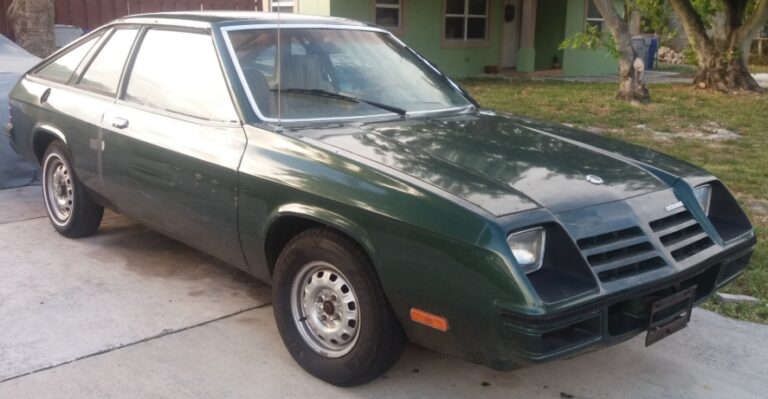The Evolution of the Pontiac T1000
The Pontiac T1000 represents a notable chapter in the history of American subcompact cars, embodying General Motors’ strategic efforts to compete in the growing economy car segment during the late 20th century. Introduced as a response to rising fuel prices and changing consumer preferences, the T1000 was a rebadged version of the Chevrolet Chevette, tailored to appeal to budget-conscious buyers seeking reliable transportation. This article traces the evolution of the Pontiac T1000, detailing its production years, models, and trim levels, offering a comprehensive understanding of its place in automotive history.
Origins and Introduction (1981-1987)
Launch and Context
The Pontiac T1000 was introduced in 1981 as part of Pontiac’s effort to expand its small car lineup. It was essentially a badge-engineered version of the Chevrolet Chevette, which itself was based on the European-designed Opel Kadett. The T1000 was developed to fill the demand for affordable, fuel-efficient vehicles during the early 1980s—a period marked by economic recession and soaring fuel prices.
Model Years and Production
- Production Period: 1981 to 1987
- Manufacturing Locations: The T1000 was assembled primarily at GM’s Lordstown Assembly Plant in Ohio.
Design and Features
The T1000 retained the compact, practical design of the Chevette, characterized by a hatchback or sedan body style, with a focus on economy rather than luxury or performance. It featured a front-engine, rear-wheel-drive layout, with a modest powertrain lineup suitable for city driving and commuting.
Model Variants and Trim Levels
During its production run, the Pontiac T1000 was offered in several trim levels, each catering to different customer preferences and budgets.
1981-1982 Models
Base Model
- The initial T1000 was marketed as the entry-level, affordability-focused model.
- Standard features included basic interior trim, manual windows, and minimal amenities.
- Powertrain options were limited, primarily featuring a 1.6-liter four-cylinder engine.
Trim Levels:
- T1000 Sedan: The four-door sedan variant, aimed at small families and urban commuters.
- T1000 Hatchback: A two-door model with a rear hatch, favored for its cargo versatility.
1983-1984 Models
Introduction of Additional Trim Levels
- By 1983, Pontiac introduced a slightly upgraded version called the Sunbird, which was essentially a more upscale version of the T1000, often sharing styling cues and features.
- The T1000 itself continued as a basic offering but with minor updates.
Features and Changes:
- Introduction of optional air conditioning.
- Upgraded interior materials in some trims.
- Introduction of a Sport package on certain models, emphasizing a sportier appearance with decals and alloy wheels.
Trim Levels:
- T1000 Standard: Basic model with manual transmission and minimal features.
- T1000 LE: A slightly more equipped version with additional comfort features like upgraded upholstery and better audio systems.
- T1000 Sport: Featured sportier exterior styling, unique wheels, and interior accents.
1985-1987 Models
Refinements and Special Editions
- The T1000 received minor cosmetic updates, including new grille designs and taillight configurations.
- The 1985 model year saw the introduction of the S/E (Special Edition) trim, aimed at offering a more stylish and feature-rich package.
Powertrain Options:
- The standard engine remained the 1.6-liter four-cylinder, with some models offered a 1.0-liter or 1.4-liter engine in certain markets, though these were less common.
- Transmission choices included five-speed manual and three-speed automatic transmissions.
Special Editions and Packages:
- T1000 S/E: Featured unique exterior decals, upgraded interior trims, and additional convenience features.
- T1000 Deluxe: Focused on comfort, with features like power steering, upgraded upholstery, and better sound insulation.
We LOVE cars & cruising around, but sometimes day trips to explore new cities are required (with family or friends) for a spice of variety in your life!
So GO explore!
Cruises & Day/Night City Tours to: Baltimore, Boston, Chicago, Marina Del Ray, New York, Niagara, Philadelphia, San Diego, San Francisco, Toronto, Washington DC, etc.:

.
End of Production and Legacy
Discontinuation (1987)
The Pontiac T1000 was phased out after the 1987 model year. Its decline was driven by a combination of factors:
- The increasing popularity of more modern, front-wheel-drive subcompact models.
- The aging design of the Chevette platform, which underpinned the T1000.
- GM’s strategic shift toward more contemporary vehicles, such as the Pontiac Sunbird and later the Pontiac Firefly.
Replacement Vehicles
The T1000’s role was gradually assumed by newer models, notably the Pontiac Firefly, introduced in 1985 as a rebadged version of the Isuzu Gemini, offering front-wheel drive and more contemporary styling.
The Significance of the Pontiac T1000
While not renowned for performance or luxury, the Pontiac T1000 holds significance as a budget-friendly, reliable transportation option during the 1980s. It exemplified GM’s badge-engineering strategy, leveraging existing platforms to quickly expand its lineup and meet market demands.
Key Highlights:
- Affordability: The T1000 was one of the cheapest new cars available in its segment.
- Fuel Economy: Its small size and efficient engines made it popular among urban drivers.
- Versatility: Offered in sedan and hatchback forms, with various trim levels to suit different preferences.
Collectibility and Modern Perspective
Today, the Pontiac T1000 is considered a classic example of 1980s automotive design—simple, functional, and emblematic of the era’s economic realities. Enthusiasts and collectors interested in vintage economy cars value well-preserved models for their historical significance and nostalgic appeal.
Summary Table of Pontiac T1000 Production and Variants
| Years Produced | Models / Trim Levels | Key Features / Notes |
|---|---|---|
| 1981-1982 | Base T1000 (Sedan, Hatchback) | Entry-level, basic features, 1.6L engine |
| 1983-1984 | T1000 Standard, LE, Sport | Introduction of optional features, sport package, minor styling updates |
| 1985-1987 | S/E, Deluxe, various trims | Cosmetic updates, special editions, continued use of 1.6L engine |
Conclusion
The Pontiac T1000’s evolution from its inception in 1981 to its discontinuation in 1987 illustrates GM’s approach to providing economical transportation during a transformative period in automotive history. Its various trim levels and models reflected the shifting consumer desires, with a focus on affordability and practicality. Although it was eventually replaced by more modern, front-wheel-drive vehicles, the T1000 remains a symbol of 1980s economic mobility and the era’s automotive ingenuity.







